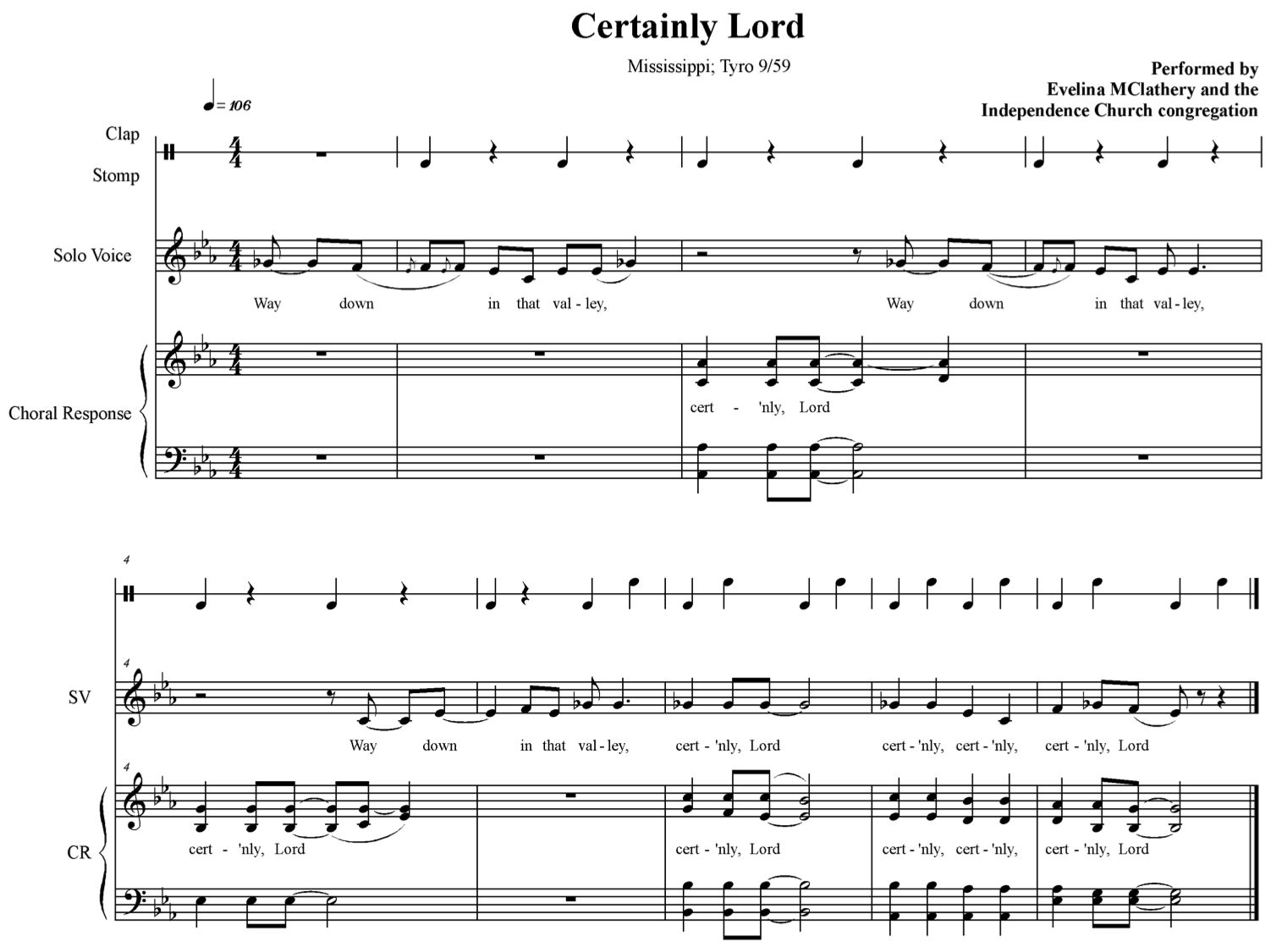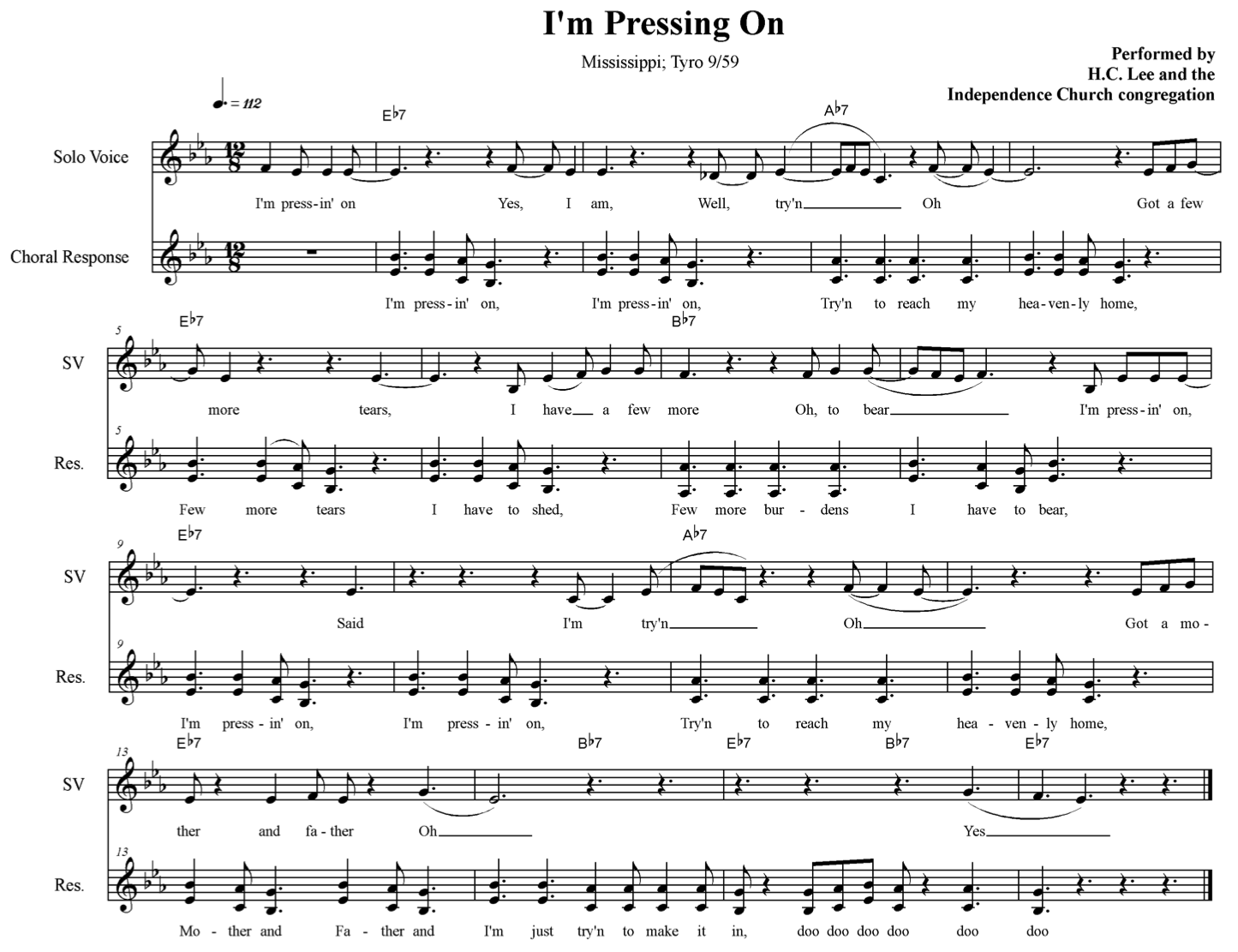Selections: (a)Trying to Make Heaven My Home, (b) Certainly Lord, and (c) I’m Pressing On
Recorded: Independence Church, Tyro, Mississippi (September 22, 1959)
Performers: (a) Viola James and congregation, (b) Evelina McClathery and congregation, (c) H. C. Lee and congregation
Activity 1: Making the Joyful Noise
1. In turning students to the style of singing of historic importance in small towns in the American south, offer them 30-45 seconds glimpses of three tunes “Trying to Make Heaven My Home”, “Certainly Lord”, and “I’m Pressing On”. Introduce this music as students are entering the room, providing a backdrop for the lesson to unfold; at most, ask them to “listen up” to the three selections and to formulate an impression such as an intelligent guess at the style of music they are listening to, or who the musicians may be, or where and when the music is performed.
2. Return to the songs one at a time, beginning with “Trying to Make Heaven My Home”. Play the recording and ask students to join in two ways, by singing the chorus (and the responses to the lead singer) tied to the words, “I’m trave’lin’, Try’n to make Heaven my home” and by stomping and clapping to match the recording.
3. With and without the recording, draw students to the vocal nuances that include sliding and some nasality (and a little rasping), and give the impression of a long and weary ride. Listen also for the harmony in thirds that are barely detectable in the chorus. Consider adjustments to the key so to accomplish singing the song with nuances in mind, a little harmony, and the continuous clapping and stomping ostinato.
4. Play the recording, “Certainly Lord”, asking students to sing the response, “Certainly Lord”, and to find the pulse to clap and stomp.
5. In repeated listenings, help students to hear and produce the harmonies to a full-fledged group response. Remind them that they are doing what people have done for time memorial in learning through the oral, non-notated, tradition to listen and find pitches that dress up and complement the single pitches. Additional verses, invented by the students, can add to the length of the song.
6. In similar fashion as the two earlier songs, move “I’m Pressing On” into the listening-and-learning experience of students. Offer them one or more opportunities to listen to the soloist and congregation, and to discover the swing and spirit of the song. Suggest that while listening, they sway left and then right as they snap their fingers to the beat of this media-influenced song.
7. Learn the harmony parts that a sung by the congregation. See the staff notation, and share it with students as a learning aid for them (although mentioning again that this music is learned by ear).
8. These three songs can comprise one or more choral rehearsals. They can be sung alone or as a medley of three spirituals, always with movement that includes body percussion to realize the essence of the songs as they were sung on the historic recordings.

Additional Lyrics:
It’s a knee-way journey, but I’m trav'lin', Try'n to make Heaven my home
It's a rough, rocky road, but I'm trav'lin',
Try’n to make Heaven my homeIt's a tedious (?) journey, but I'm trav'lin',
Try'n to make Heaven my home
Transcription by James B. Morford
Activity 2: The Stories Behind the Joyful Noise
1. In the small rural community of Tyro, Mississippi, in the northern hill country, the Independence Church functioned in 1959 as a centerpiece of people’s lives. Find Tyro on a map, and also Sardis Lake and the surrounding towns of Looxahoma, Como, Senatobia (the seat of Tate County). Speculate as to life in a small town, and research photos, stories, and goings-on in African-American life in northern Mississippi then (ca. the late 1950s) and now.
2. Consider that the featured songs in the Tyro church are in transition between spirituals and gospel, given the flavor of their call-and-response techniques, the movement and body percussion of their performances, and certainly their religious texts. Return to the lyrics of the songs, and discuss them with lead questions like these:
-Trying to Make Heaven My Home: “Where is the singer trav’lin’ to?” (Answer: to heaven), “What sort of journey?” (Answer: It’s a knee-way journey, a rough, rocky road, a tedious journey to heaven)
-Certainly Lord: “What is the meaning ‘way down in that valley’?” (Answer: a place where people who have lived good lives are happy)
-I’m Pressing on: “To what avail are the singers “pressing on”? (Answer: “to reach my heavenly home”)
3. Discuss how religious song was in transition in African American at the time of these collections. The old spirituals, locally known as “hallies” (hallelujah), were receding in favor of gospel hymns and Holy Roller shouts. In conversation with Reverend Martin, Alan Lomax told the story of transition: “You see, in the modern Baptist church we are trying to move on past the wonderful old cornbread spirituals and sermons, as they say, with gravy on them. We want to bring our people forward with a new and more progressive type of music…the old sister leading songs from the back row is being replaced by an educated musical director.” (Lomax, p. 46). Ask students whether the selections sound “old” or “new” to them (Answer: They are examples of 1950s “new” church music). Note how this “new” music is now historic, comparing them to musical examples of the African American mass choir such as those of James Cleveland.
Lesson Plan by Patricia Campbell


